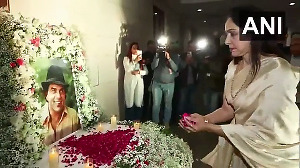Sonia Gandhi must have learned her share of Roman history in her schooldays; she gave her hand-picked prime minister a tribune's power. Dr Manmohan Singh had little say in appointing his ministers but he could veto others from entering the council of ministers. Some of the old faces were kept out at the apparent intercession of the prime minister, others were rejected by the voters.
While the Congress swept Andhra Pradesh, Renuka Chowdhary lost Khammam by over 100,000 votes. Mani Shankar Aiyar was defeated from Mayiladuthurai though the DMK-Congress alliance did well in Tamil Nadu. Santosh Mohan Dev was beaten in Silchar though his party won half the seats in Assam.
Five years ago Shivraj Patil became Union home minister despite losing from Latur and P M Sayeed became power minister fresh from his loss in Lakshadweep. This time the voters' mandate has been respected.
So much for the electors's veto, how about that of the prime minister? T R Baalu was elected from Sriperumbudur. Arjun Singh and Hans Raj Bhardwaj are both sitting Rajya Sabha members. Nevertheless, all three were kept out -- and by all accounts it was at Dr Manmohan Singh's own initiative, out of exasperation at their poor records.
Most Indians would be grateful to the prime minister for exercising the veto. That said, it is idle to pretend that this ministry will be particularly efficient.
There is already heartburn in some quarters in Delhi. The single largest contingent of Congress MPs come from Andhra Pradesh, where the party won 33 of the state's 42 Lok Sabha seats. Only one of those MPs is a full-fledged Cabinet minister, S Jaipal Reddy.
Meghalaya has only two Lok Sabha constituencies, Tura and Shillong, with the NCP winning the first and the Congress getting the second. The NCP insisted on making Agatha Sangma a minister so the Congress made Vincent H Pala one too.
The biggest snub of all has been to Uttar Pradesh, where the Congress stunned everyone by winning 21 seats. There is not a single full-fledged Cabinet minister from the state even if there are ministers of state.
In theory none of this should matter since ministers are supposed to consider the interests of all of India, not of their own home state. The practice belies the theory. Railway Minister Mamata Bannerjee has already made it clear that she can keep only half an eye on her duties in Delhi. Many of her colleagues shall think on similar lines.
Even if every state got its due, the very structure of the council of ministers breeds inefficiency. Far too many people had to be accommodated and jobs found for each. Each minister -- bureaucrats too -- will now build little fiefdoms.
The United States is served by a single transport secretary in President Obama's cabinet. How about India, about a third the area of the United States? We have a railway minister, a road transport minister, a shipping minister, and a civil aviation minister. Good luck trying to build a holistic policy out of that set-up!
Or take the racial attacks on Indians in Australia. Who deals with those, the external affairs minister or the minister for overseas Indian affairs?
The United States has a single energy secretary. (The 1997 Nobel Laureate in physics!) What happens if Steven Chu wants to talk to his Indian counterpart? Does he call Power Minister Sushilkumar Shinde, or Petroleum & Natural Gas Minister Murli Deora, or Coal Minister Shriprakash Jaiswal, or New & Renewable Energy Minister Farooq Abdullah? Or possibly Dr Manmohan Singh, who retains the Department of Atomic Energy?
The confusion does not stop there. Jaipal Reddy is the urban development minister but Kumari Selja handles housing & urban poverty alleviation. Does that mean Reddy builds auditoriums for the rich and the middle class while his colleague puts up houses for the poor?
Anand Sharma is the commerce & industry minister. But we also have a minister for heavy industries & public enterprises (Vilasrao Deshmukh). And a steel minister (Virbhadra Singh). A textiles minister (Dayanidhi Maran). A minister for food processing industries (Subodh Kant Sahay). A minister for chemicals & fertilisers (M K Alagiri). A minister of micro, small & medium enterprises (Dinsha J Patel). So what exactly is Anand Sharma's responsibility?
Mukul Wasnik is social justice & empowerment minister. Kantilal Buria handles tribal affairs. Salman Khurshid has the minority affairs portfolio. Krishna Tirath has independent charge of women & child development. Who claims jurisdiction in a case involving a tribal Christian woman?
And then there is M S Gill, who handles the most useless portfolios of them all, sports & youth affairs. The only sport India cares for is cricket, and the BCCI is the one sports federation that refuses to report to the sports ministry. (Probably why cricket does relatively well!) As for 'youth affairs', what is that? Child abuse will be handled by Krishna Tirath, education by HRD Minister Kapil Sibal, and jobs by Labour & Employment Minister Mallikarjun Kharge.
What does that leave?
It is good that Dr Manmohan Singh exercised his veto; it would have been better had he wielded the tribune's privilege a lot more.
There is one final point. Roman law dictated that a tribune could not be a patrician but had to be chosen directly by the common people. It is a shame that the world's largest democracy still has a chief executive who does not belong to the House of the People.





